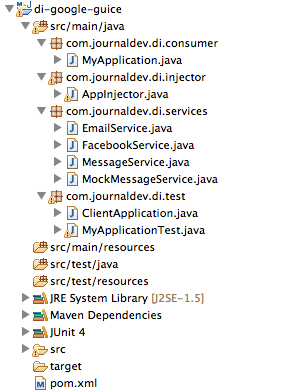Google Guice Dependency Injection Example Tutorial
Google Guice is the framework to automate the dependency injection in applications. We learned how we can implement dependency injection in applications manually. But when number of classes grow in an application, it’s better to look for some framework to automate this task. Google Guice is one of the leading frameworks whose main work is to provide automatic implementation of dependency injection. We will work on the same example from last post and learn how can we use Google Guice to automate the implementation process for dependency injection. Google Guice dependencies are available on maven central, so for maven projects you can add below dependency for it.
<dependency>
<groupId>com.google.inject</groupId>
<artifactId>guice</artifactId>
<version>3.0</version>
</dependency>
If you have a simple java application, then you can download the jar file from Google Guice Home Page on Google Code. Note that in this case you will also need to have it’s transitive dependencies in the classpath or else you will get runtime exception. For my example, I have a maven project whose project structure looks like below image.
 Let’s see each of the components one by one.
Let’s see each of the components one by one.
Service Classes
package com.journaldev.di.services;
public interface MessageService {
boolean sendMessage(String msg, String receipient);
}
MessageService interface provides the base contract for the services.
package com.journaldev.di.services;
import javax.inject.Singleton;
//import com.google.inject.Singleton;
@Singleton
public class EmailService implements MessageService {
public boolean sendMessage(String msg, String receipient) {
//some fancy code to send email
System.out.println("Email Message sent to "+receipient+" with message="+msg);
return true;
}
}
EmailService is one of the implementation of MessageService. Notice that class is annotated with @Singleton annotation. Since service objects will be created through injector classes, this annotation is provided to let them know that the service classes should be singleton objects. Google Guice 3.0 added the support for JSR-330 and we can use annotations from com.google.inject or javax.inject package. Let’s say we have another service implementation to send facebook messages.
package com.journaldev.di.services;
import javax.inject.Singleton;
//import com.google.inject.Singleton;
@Singleton
public class FacebookService implements MessageService {
public boolean sendMessage(String msg, String receipient) {
//some complex code to send Facebook message
System.out.println("Message sent to Facebook user "+receipient+" with message="+msg);
return true;
}
}
Consumer Class
Since we are implementing dependency injection in our application, we won’t initialize the service class in application. Google Guice support both setter-based and constructor-based dependency injection. Our application class that consumes the service looks like below.
package com.journaldev.di.consumer;
import javax.inject.Inject;
//import com.google.inject.Inject;
import com.journaldev.di.services.MessageService;
public class MyApplication {
private MessageService service;
// constructor based injector
// @Inject
// public MyApplication(MessageService svc){
// this.service=svc;
// }
//setter method injector
@Inject
public void setService(MessageService svc){
this.service=svc;
}
public boolean sendMessage(String msg, String rec){
//some business logic here
return service.sendMessage(msg, rec);
}
}
Notice that I have commented the code for constructor based injection, this comes handy when your application provides some other features too that doesn’t need service class object. Also notice the @Injector annotation, this will be used by Google Guice to inject the service implementation class. If you are not familiar with annotations.
Binding Service Implementation
Obviously google guice will not know which service to use, we have to configure it by extending AbstractModule abstract class and provide implementation for configure() method.
package com.journaldev.di.injector;
import com.google.inject.AbstractModule;
import com.journaldev.di.services.EmailService;
import com.journaldev.di.services.FacebookService;
import com.journaldev.di.services.MessageService;
public class AppInjector extends AbstractModule {
@Override
protected void configure() {
//bind the service to implementation class
//bind(MessageService.class).to(EmailService.class);
//bind MessageService to Facebook Message implementation
bind(MessageService.class).to(FacebookService.class);
}
}
As you can see that we can bind any of the implementation to service class. For example, if we want to change to EmailService we would just need to change the bindings.
Client Application
Our setup is ready, let’s see how to use it with a simple java class.
package com.journaldev.di.test;
import com.google.inject.Guice;
import com.google.inject.Injector;
import com.journaldev.di.consumer.MyApplication;
import com.journaldev.di.injector.AppInjector;
public class ClientApplication {
public static void main(String[] args) {
Injector injector = Guice.createInjector(new AppInjector());
MyApplication app = injector.getInstance(MyApplication.class);
app.sendMessage("Hi Pankaj", "pankaj@abc.com");
}
}
The implementation is very easy to understand. We need to create Injector object using Guice class createInjector() method where we pass our injector class implementation object. Then we use injector to initialize our consumer class. If we run above class, it will produce following output.
Message sent to Facebook user pankaj@abc.com with message=Hi Pankaj
If we change the bindings to EmailService in AppInjector class then it will produce following output.
Email Message sent to pankaj@abc.com with message=Hi Pankaj
JUnit Test Cases
Since we want to test MyApplication class, we are not required to create actual service implementation. We can have a simple Mock service implementation class like below.
package com.journaldev.di.services;
public class MockMessageService implements MessageService{
public boolean sendMessage(String msg, String receipient) {
return true;
}
}
My JUnit 4 test class looks like below.
package com.journaldev.di.test;
import org.junit.After;
import org.junit.Assert;
import org.junit.Before;
import org.junit.Test;
import com.google.inject.AbstractModule;
import com.google.inject.Guice;
import com.google.inject.Injector;
import com.journaldev.di.consumer.MyApplication;
import com.journaldev.di.services.MessageService;
import com.journaldev.di.services.MockMessageService;
public class MyApplicationTest {
private Injector injector;
@Before
public void setUp() throws Exception {
injector = Guice.createInjector(new AbstractModule() {
@Override
protected void configure() {
bind(MessageService.class).to(MockMessageService.class);
}
});
}
@After
public void tearDown() throws Exception {
injector = null;
}
@Test
public void test() {
MyApplication appTest = injector.getInstance(MyApplication.class);
Assert.assertEquals(true, appTest.sendMessage("Hi Pankaj", "pankaj@abc.com"));;
}
}
Notice that I am binding MockMessageService class to MessageService by having an anonymous class implementation of AbstractModule. This is done in setUp() method that runs before the test methods.
That’s all for Google Guice Example Tutorial. Use of Google Guice for implementing dependency injection in application is very easy and it does it beautifully. It’s used in Google APIs so we can assume that it’s highly tested and reliable code. Download the project from above and play around with it to learn more.


